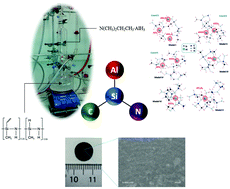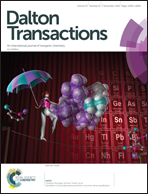Crosslinking chemistry of poly(vinylmethyl-co-methyl)silazanes toward low-temperature formable preceramic polymers as precursors of functional aluminium-modified Si–C–N ceramics†
Abstract
Crosslinking chemistry of a liquid poly(vinylmethyl-co-methyl)silazane with an alane hydride-based complex according to Si : Al ratios varying from 5 to 2.5 has been investigated in detail through the characterization of the as-obtained polymers using solid-state NMR, FT-IR and elemental analyses. This reaction allows tailoring the chemical and physical properties of the neat liquid polysilazane while extending its processability to lead to a series of low-temperature formable aluminium-modified polysilazanes. Structural models have been established based on solid-state NMR spectroscopy. Then, pyrolysis under nitrogen occurring the conversion of polymers into ceramics has been studied by coupling TG experiments with FTIR of pyrolysis intermediates. Pyrolysis at 1000 °C leads to X-ray amorphous Al-modified silicon carbonitride materials with higher ceramic yields compared to the materials obtained from the neat polysilazane. However, the increase of the ceramic yield is minimized with the decrease of the Si : Al ratio from 5 to 2.5 in the as-obtained polymers. This is due to the introduction of –NR3 (R = CH3 and C2H5) units as side groups during the polymer synthesis which are released in the low temperature regime of the pyrolysis. The structural evolution of the amorphous network of ceramics has been studied by annealing up to 1800 °C though X-ray diffraction and Raman spectroscopy. Such studies point out that samples remain amorphous even after annealing at 1400 °C (low Si : Al ratio) and 1600 °C (high Si : Al ratio) before forming Si3N4/SiC/AlN and AlN/SiC/C composites after annealing at 1800 °C depending on the Si : Al ratio fixed in the early stage of the process. Dense pieces could be prepared from these low-temperature formable polymers. The latter, especially those containing a certain portion of –NR3 (R = CH3 and C2H5) units acting as plasticizing groups during the process, display appropriate requirements for pressing at low temperature forming dense pieces with hardness and Young's modulus as high as 21.7 GPa and 192.7 GPa, respectively.



 Please wait while we load your content...
Please wait while we load your content...